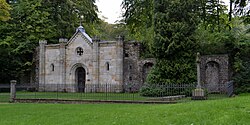Mausoleum on the Büchenberg
| Mausoleum on the Büchenberg | |
|---|---|
 View from the west |
|
| Data | |
| place | Detmold |
| Construction year | 1705-1712 / 1855 |
| Coordinates | 51 ° 55 '24.5 " N , 8 ° 52' 2.9" E |
The mausoleum on Büchenberg in Detmold in the North Rhine-Westphalian district of Lippe was originally part of the Friedrichstaler Canal and was converted into a mausoleum for the members of the Lippe Princely House in the mid-19th century .
Since January 7, 1983 the mausoleum has been entered in the list of monuments of the city of Detmold.
History and architecture
The grotto as part of the Friedrichstaler Canal

Under Count Friedrich Adolf , the construction of the Friedrichstaler Canal began in 1701 . After the canal work was completed in 1704, the so-called “shell grotto” was built between 1705 and 1708 and 1712 based on a design by Hans Hinrich Rundt . The Dutchman Jan Krose was the site manager.
Inside, the niches on the right, left and at the front end were given shell-shaped ends, and the walls, clad with marble slabs, were decorated with polished shells. As with the residential palace , stucco work was carried out by the Italian M. Camminata. Tubes in the floor should surprise visitors with "little splashes". The ceiling was designed as a cross vault with a slate-covered, octagonal tower, through whose window light fell into the grotto. According to Gaul, the front was defined by four rusticated pilasters , in the middle there was a round arched portal, on the right and left a rectangular door. The front was completed at the top by an entablature with a balustrade .
A fire in the New Orangery marked the beginning of the end of the Friedrichstaler Canal project . There were insufficient financial resources to maintain the facility, and the shell grotto began to decline. When Count Simon August took over the reign in 1748, he ordered the sale of the grotto masonry as building material. In 1803, Princess Pauline had the interior renewed, but without reusing the building.
The conversion to a mausoleum
Until the middle of the 19th century, the members of the House of Lippe were buried in a crypt under the Erlöserkirche on the market square. Lack of space forced Leopold III. However, to look around for a new burial place, and so the idea of converting the neglected grotto into a mausoleum came up. In 1855, the facade was rebuilt in neo-Gothic style with polygonal battlements and gable, and the forecourt was enclosed with neo-Gothic latticework between polygonal pillars. Then the bones of Leopold II and Prince Karl were reburied in the mausoleum, the transfer of further coffins followed in July 1908. Also in 1908 the newly built Christ Church was inaugurated in Detmold , in whose crypt the bones of the Lippe-Biesterfeld line were buried from then on .
The November Revolution of 1918 marked the end of the monarchy in Germany and with it the reign of the Princely House of Lippe. The mausoleum fell to the Free State of Lippe and later, as legal successor, to the Landesverband Lippe . Extensive renovations have been carried out over the years by the Free State and the regional association. a. In 1930 the niches in the right wing wall were restored and in 1949 the roof vault, which had been destroyed by the war, was renewed. Even after the end of the monarchy, members of the Lippe family were buried in or in front of the mausoleum.
Nowadays there are eight niches to the right and left of the room to accommodate the coffins, in the middle there are two artistically significant splendid lead sarcophagi. These contain the bones of Count Friedrich Adolf and Count Simon Heinrich Adolph . There are more graves in the fenced-in forecourt.
In 2010 the Friends of the Residence put up information boards along the Friedrichstaler Canal. In the course of this, the trees in front of the mausoleum were cleared so that it can be freely seen from Paderborner Straße since then.
literature
- Otto Gaul : Stadt Detmold (= The architectural and art monuments of Westphalia . Volume 48.1 ). Aschendorff, Münster 1968.
- Burkhard Meier: The mausoleum on Büchenberg near Detmold . Lippischer Heimatbund, Detmold 1988, ISBN 3-926311-68-1 .
Web links
Individual evidence
- ^ Burkhard Meier: The mausoleum on Büchenberg near Detmold .
- ↑ Geodata Portal City of Detmold (PDF; 12 kB) Retrieved on July 7, 2012.
- ^ Otto Gaul: City of Detmold .
- ↑ Erich Göpfert: Lippe and his regional association . Ed .: Arnold Ebert. Lippischer Heimatbund, Detmold 1969.

